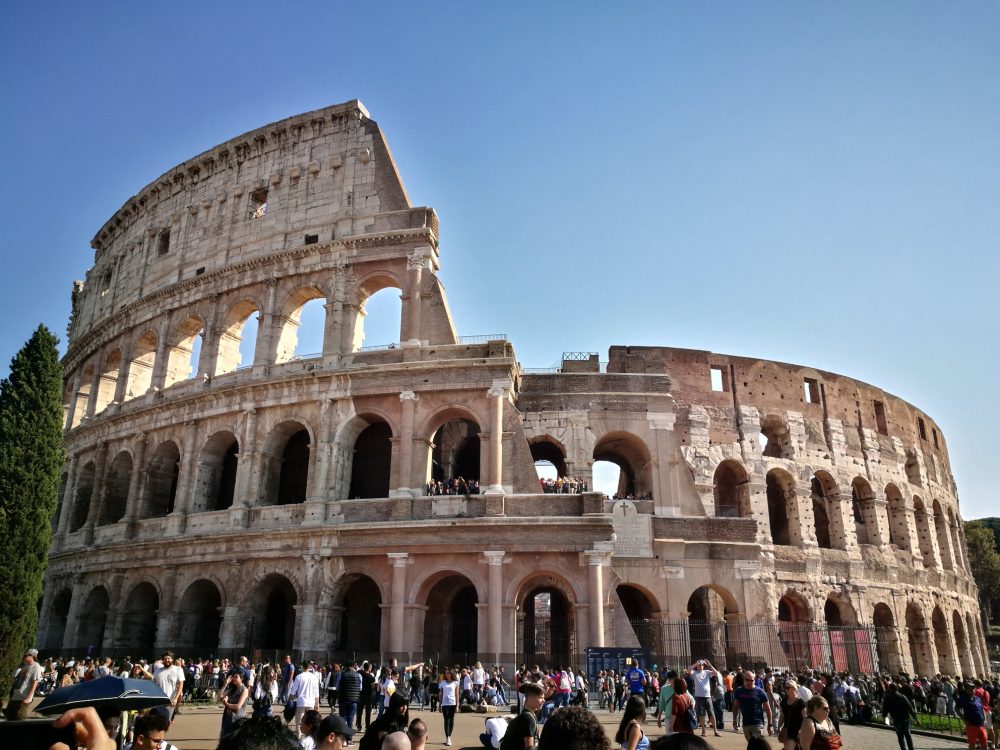Rome – when we imagined it we pictured paying high prices to queue around crowded monuments so we’ve put it off for many years. Is it possible to avoid the crowds in Rome? And does it need to be expensive?
I’m writing this whilst heading home from a child-free weekend in Rome in October (we finally went!). It’s not entirely in the spirit of family travel, but every couple needs time alone from the kids and this weekend has helped us shape some thoughts for the gap year so I wanted to share it.
We went in October, so the temperatures were reasonable (still hot though!) and the tourist levels were high. Whilst we did see many of the big draws, the Vatican, St Peter’s Basilica, the Sistine Chapel, Trevi Fountain, Spanish Steps and the Colosseum, pretty much all of our highlights of this weekend were the ones we didn’t pay for!
So if you want some ideas for heading to Rome and finding things to do which are cheap, uncrowded and worth seeing read our 8 favourites below.
Our favourite things to do to avoid the crowds in Rome and save your pennies
1) The bones of nearly 4,000 friars mounted on the walls as art in the Capuchin Crypts
After walking through the museum of the Capuchin monks you enter the Ossyri or crypts in which someone (still some debate as to who and why) arranged the stored bones of about 3,700 monks into scenes and art(?). I imagine there are a wide range of reactions to this place but I personally was amazed and my first reaction was that it was quite beautiful. I think in part that is because when I first saw it it looked like a hall with carved wood decorating the arched ceilings and it looked good. It’s not until you look closer that you realise that it is a line of jaw bones or vertebrae! Had I known what I was looking at initially my reaction may have been different! The ceiling parts looked good; the re-created and dressed bodies of the monks surrounded by piles of skulls not so much… Very surreal and probably not like anything you’ve seen before.
This place was also great as there was hardly anyone here so we could take our time and really look at it. There was also lots of information in English so we could understand something about the monks before we went in and about how and why the bones are there.
Located at Via Vittorio Veneto 27 Rome and costs 10EUR each for entrance.
You will need to have your knees and shoulders covered (if they aren’t you will have to buy their cheap coverall for 1EUR).
2) Our surprise building and our favourite – the ‘Typewriter’ building. Actually called the Monumento a Vittorio Emanuele II.
We had no plans to see the Typewriter building but passed it on route to the Colosseum and had to go and have a look. It’s visible from many places when walking the main tourist routes as a massive white layered building with chariot statues on top and it towers above the surrounding buildings when seen from a distance. I loved all the layers – it’s a stunning building.
As an added bonus, there are some steps up on the right-hand side which take you to an unassuming church which is beautiful inside. Another set of sloped steps to the right of this take you up to where you can enjoy a view over the Roman Forum.
3) The Via Appia and old walls – a great way to avoid the crowds in Rome
The Via Appia or Appian Way was one of the earliest and strategically most important roads in ancient Rome connecting Rome to Brindisi and parts of its cobbled streets still exist and can be walked on today.
We walked down from the Colosseum, past the baths (see below) and down Via di Porta Latina to look at the church of San Giovanni – one of the oldest in Rome with some very old crumbling paintings on the wall. The site I found this on claimed it was also one of the most picturesque – we were not so enamoured with it after others in Rome but it’s worth a stop in passing.
After exiting we headed across the road and then through a park on the right to get to the cobbled street walled in on both sides – the Via di Porta San Sebastiano. At the end is an old gatehouse, and a slightly newer one which is part of the walls. There is a museum here and you can apparently climb to the top for good views. Unfortunately for us, it is closed on Monday’s so we couldn’t try this for ourselves.
Through the gate, the Via Appia Antica continues straight ahead into a park with some catacombs. As the Vatican had taken so much more of our time than anticipated we had to start heading back so followed the walls to the West. This was a pleasant walk along quiet streets all the way to the Pyramide di Caio Cestio (the white pyramid). From here we headed into Trastavere across the bridge for dinner. This is meant to be a ‘hip’ area great for food although we didn’t find it very different to the rest of Rome (but then we’re not very architecturally tuned in). More lovely cobbled streets.
We saw no other tourists along this route which was very refreshing after the Vatican hordes. Note that due to the lack of tourists there are no places to get food or snacks on route from the Colosseum area to the Pyramid.
4) The Terme di Caracalla – the Baths of Caracalla
5) The Colosseum (from the outside)
The whole area around the Colosseum is a disaster zone during the day (especially with the new Metro line works going on in Oct 2018) but there is no denying that the Colosseum is a great building and a must see despite the crowds – especially from the outside. At night the area was much quieter, and it looks great under lights too.
We did go in with a skip-the-line ticket (still had to queue for 20 mins), but to be honest I found it a little underwhelming inside (and pretty crowded). There is not much information and only a few diagrams to show what it would have looked like. I don’t feel like I gained much from being in there – I guess Gladiator the film ruined the impact for me a bit as it seems much larger in the film so I was expecting more ☹.
6) St Peter’s Basilica – see the opulence of the Vatican without hours of queues
We did the Vatican Museum and Sistine Chapel Tour followed by St Peter’s Basilica (skip the queue again). The Vatican Museums were like some form of torture for us, being herded in one direction around most of the museum in one hot sea of slow-moving people. It took us over an hour to get from the start to the Sistine Chapel and the Sistine Chapel was underwhelming; by this point it’s just another hot crowded room with an ornately painted ceiling and there are many of these in the Vatican Museums. Michelangelo’s painting of judgement day is very interesting, and we were pleased we’d had the tour guide to explain what we were seeing so we could understand it. But as non-spiritual people who are not that familiar with the stories of the bible, it didn’t mean enough to us to make it the queueing worthwhile.
On the other hand, St Peter’s Basilica, which we nearly skipped as by then we were desperate to get away from the crowds and get a drink, was stunning and immense (and less crowded).
This whole area felt like a show of how ridiculously opulent The Church is though which seemed like a bit of a contradiction to us. If we did it again we’d pay a lot less and get the St Peter’s Basilica ticket and ignore the Vatican Museums and Sistine Chapel and this is what we’d recommend anyone else does unless you have a specific interest in the Vatican or Sistine chapel.
[siteorigin_widget class=”SiteOrigin_Widget_Image_Widget”][/siteorigin_widget]
7) Old streets of Rome – wander quaint walkways
8) The Valle Borghese Park – a great escape from the crowds, especially for kids
A large, shady and beautiful park to spend some time in. We sat on a bench to read a book for an hour on our last morning; killing some time and resting tired legs after two long days of walking. There are rowboats, pedal go-carts and bikes for hire to explore this park – one of the largest urban parks in Europe apparently. We had our suitcases in tow so we didn’t get far in.
Our learnings:
Rome – all in all, a lovely weekend in a beautiful city!
What we loved:
- there are drinking fountains dotted about for refilling water bottles in the more touristy areas (inside the Colosseum for instance).
- almost every street is beautiful, there didn’t seem to be any ‘bad’ bits
- our accommodation. The B&B Maru Shelter at the south-west tip of the Vatican City for about 75EUR per night. A lovely set up with clean bright rooms and a shared kitchen and terrace.
- Food was also not as expensive as expected in a capital city (about 9-12EUR per main in the restaurants we ate in) although the price of beer varied widely though – one rooftop bar was charging 10EUR a pint!
What we were not such a fan of:
- the crowds. Outside the Collusseum was chaos, the Spanish Steps were similarly underwhelming for us as from the bottom you couldn’t actually see any steps, only people, and it was hard to get near the Trevi fountain at all.
So what travel learnings do we have from this trip?
From this, we’ve learnt that crowds like these totally spoil everything for us so when travelling we will avoid these crowded tourist hotspots unless it’s something we are desperate to see (like the Great Wall of China) in which case we’ll pay more to get to a less touristy area or go without crowds.
A couple of quick tips for those who have not been before to close;
– many of the churches/crypts will make you buy something to cover up if you have your knees or shoulders uncovered
– there are drinking fountains dotted about for refilling water bottles in the more touristy areas (inside the Colosseum for instance).
– Take a wander rather than just getting the metro between sites – it’s a beautiful city

